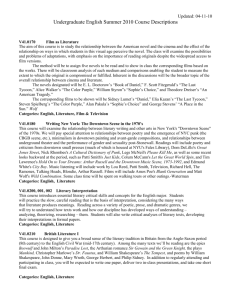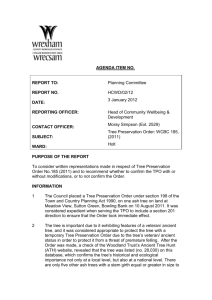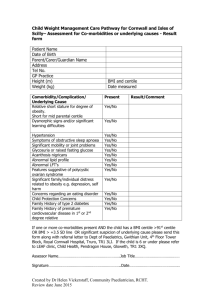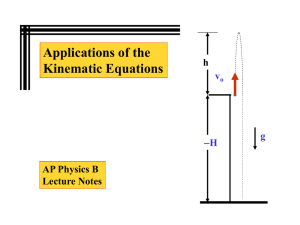Pacific NW TPO Project - ElectronicsRecycling.Org
advertisement
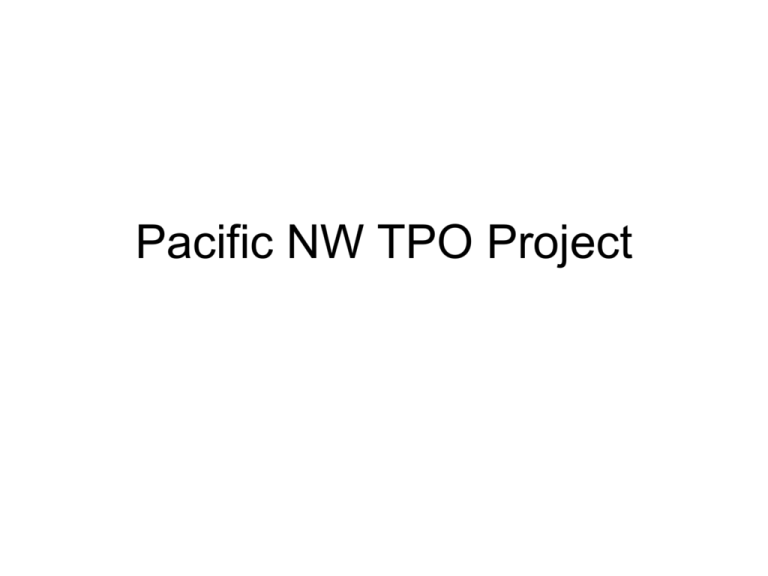
Pacific NW TPO Project Background • Idea from Pilot Program experiences – One central body could coordinate manufacturer input, participation • Developed proposal through Northwest Product Stewardship Council – EPA seed funding – Recruited manufacturers to fund and sit on Steering Committee to direct process • Kickoff announcement at EPA National Meeting – Official project start in May 2005 Project Structure • Steering Committee – 8 contributing manufacturers only – Decide on project direction, final say on project recommendations • Support Team – NWPSC government reps, NCER, RBRC, consultants – Prepare documents, notes, tee up decision items for Steering Committee Conceptual Business Plan • Models the TPO directly, using a set of assumptions approved by Steering Committee • Allows for cost scenarios, collection volume projections, plans for resources needed • Sets specific goals, targets, and indicators for the TPO Major Assumptions • TPO is industry-led, non-profit entity • Works under state legislation – But conceived as serving multiple states – OR and WA • Funded via an ARF on retail sale/first sale into state – Covers all eligible sales, and funds all aspects of recycling infrastructure (collect, transport, recycle, education) – via single TPO • Product Scope: Desktops, laptops, TVs, monitors Major Findings • Startup costs needed before fee collection begins: $1.5 million • Total Costs first 4 years: $29 million • Fee per unit: – – – – – – TV unit >19“ $6 TV unit <19“ $3 Desktop PC unit $2 CRT/large LCD monitor $4 LCD monitor unit <22“ $2 Laptop unit $1 • Costs cover anticipated collection volumes of 1.35 lbs per capita Year One ramping up to 2.6 lbs per capita in Year Four Hybrid TPO Model • State-level: quasi-governmental E-Waste Commission – Created in legislation, members appointed by Governor (could be majority manufacturers, other stakeholders) – Sets ARF, collects from retailers/first sellers, enforces payment – Oversees program performance – Creates agreement with private TPO that runs collection/recycling system Hybrid TPO Model Cont’d • Multi-State: independent TPO, likely nonprofit entity – Provides all collection, recycling, transportation services through agreements with one or more state E-Waste Commissions – Competitively contracts with multiple consolidation points – Contractors paid on per-lb basis, with a passthrough Collection Incentive Payment Why the Hybrid TPO Model? • Desire for true multi-state administration of recycling program to gain economies of scale • Special purpose state agency has more authority on fee collection than wholly private TPO • Avoid need for existing state agency to add fee collection and recycling program management to existing responsibilities Benefits of Hybrid TPO Model • Leaves control of funding at state level • Allows multi-state entity to realize operational, administrative, and scale efficiencies • Involves manufacturers in E-Waste Commission and/or independent TPO operations – Improve information flow in chain of commerce on product design characteristics, recycling challenges, communication with contracted recyclers Other Business Plan Highlights • Collection: free, convenient, at least one ongoing site in every town over 10,000 – Assumed 15 cents/lb, includes transport to consolidation center, 3 cent/lb more for distant areas – TPO contracts with consolidators who compete for local collection sites or provide collection directly Other Business Plan Highlights • Processing: estimates avg 24 cents/lb – Will be reduced over time through competitive contracting – Contract consolidators obligated to follow ESM standards and data reporting • Education: shared between TPO and local communities – Estimated $300k per year TPO costs What Resources Does the TPO Need? • Planning for TPO resource requirements – Key driver: expected volumes from residents, businesses, and institutions – Used existing programs as basis for increasing collection volume over 4 years – From projected Year 1 CA volume to Hennepin County current volume • 81% of TPO costs from collection, transport, recycling • $29M needed for four years, divided among covered product sales = $1- $6 per product Planning for Uncertainty • What if collection volumes are substantially higher? – E-Waste Commission would be authorized to adjust fees – Sequence plans for revenue collection to have cash reserve (i.e. fee collection begins before contractor payments due) • If collection volumes lower: TPO can adjust Collection Incentive Payment higher TPO Staffing • Strong contracting role, minimal operational responsibilities, therefore: – Executive Director – Contract Manager – Accounts Payable Manager – Communications Directors – Office Manager – Administrative Support TPO Viability Analysis • Performed to model scenarios where TPO has less than 100% participation – TPO not responsible for managing entire system or meeting entire collection goal • 1st Scenario – companies “opt-out” but TPO admin and education costs fixed – Impact: fixed costs 2% higher with 85% TPO participation, 10% higher at 50% participation TPO Viability Scenarios • 2nd Scenario – single state implementation – Impact: fixed admin costs 22 cents per household higher in WA, and 70 cents higher in OR / equals 3 cents/lb and 10 cents/lb of collected electronics, respectively • 3rd Scenario – Fewer economies of scale if TPO manages only 85% of system – Impact: Per unit costs for TVs $5.25 instead of $4.50, monitors $4 instead of $3.50 Legal Questions with a TPO • Legal analysis performed for project on the following topics: – Anti-trust issues associated with manufacturer participation – Liability concerns for participating manufacturers – Need for Interstate Compacts – Types of prohibited speech for TPO – Legal precedents/constraints for TPO structure in WA and OR Legal Analyses Highlights • Antitrust Issues – State legislation would exempt TPO from antitrust – Need to prevent improper info disclosure through antitrust policy adoption – Avoid activities that would exclude competitors • Liability concerns – “Piercing” doctrine for corporations limits liability for any shareholder or member (i.e. manufacturer in TPO) – State legislation could also provide protection, but well managed program should have limited exposure – Federal Superfund exemption for “arranging for recycling of recyclable material” Legal Analyses Highlights Cont’d • Interstate Compacts – Congressional approval not necessary when it does not increase political power of states – could be possible to write E-Waste Commission Compact without Congressional action • Prohibited Speech – WA Apple Commission case where members were compelled to support objectionable speech – Conclusion: TPO needs government control or have limited advertising role to avoid 1st amendment challenges Legal Analyses Highlights Cont’d • Legal Issues: Gave law firm with 2 “strawmen” TPO models; quasi-government, and private – Research any legal constraints on models • Quasi-Government: Apple Commission model – WA/OR legislatures could assess tax or fee on sales/distribution to fund this “special-purpose state agency (SPSA)” – Unclear whether SPSA could assess fee on manufacturers/distributors – need justification that it compensates burden from their activities – Manufacturers could have input and control of Commission/SPSA, with government oversight – Multi-state Commission/SPSA unlikely, need Compact Legal Analyses Highlights Cont’d • WA/OR Legal Issues Cont’d: Private, Non Gov’t TPO – Ensuring universal funding participation problematic – Could be funded like Commission if existing state agency collects/enforces fee; TPO then contracts with agency OR – Require OEMs/distributor to join/fund private entity as condition of sale in state/s – If funded by fee/tax imposed by govt agency, industry cannot have control over level of fee/tax – Private org more flexible for multi-state operations, but need to ensure legislatures coordinate Incorporating Other Stakeholder Concerns • Parallel to NWTPO project, National Center for Electronics Recycling MSTPO committees formed – General stakeholders – Recyclers Committee • Separate due to contractual nature with potential TPO – Produced TPO Fact Sheet, Matrix of TPOs in existing/proposed programs, and survey on TPO preferences Stakeholder Feedback • Major concerns addressed by business plan, explanation in Appendix E • Sample Concerns/Preferences: – – – – Strong desire for multi-state TPO Need to see precedent issues resolved Fear of monopolistic TPO, cuts out local actors Criticism that TPO allows manufacturers to escape responsibility – Desire for transparency in TPO operations, contracting decisions (recyclers) – Preference for multiple TPOs (NGO, but not govt) Addressing Stakeholder Feedback • Government oversight role addresses most concerns – Others dealt with in provisions of legislation under which TPO operates • Other stakeholders assumed to be represented on TPO Board • Goals set to ensure manufacturers are engaged in recycling process, aware of design challenges • TPO leaves many infrastructure decisions at local level – contracts but does not direct Spreadsheet Model • Final report includes spreadsheet documenting all major cost/collection volume assumptions • Stakeholders can verify or provide feedback
